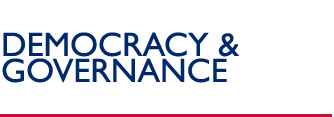Democracy and Governance in Liberia
The Development Challenge: For fourteen years from 1989 to the signing of the Accra Comprehensive Peace Agreement (CPA) in August of 2003, Liberia was in a constant state of conflict. In a nation of only three million people, it is estimated that the war took over 250,000 lives and displaced a million people, including hundreds of thousands of refugees who fled the country. Rape and other forms of sexual violence against women and girls were pervasive. It is difficult to exaggerate the devastation this protracted civil war has had on Liberia's physical, social, political and economic infrastructure. Liberia's human development indicators reflect the alarming condition of its people. Over 80% of Liberia's population is illiterate and lives below the poverty line. The unemployment rate exceeds 70%. Thirty-five percent of Liberians are malnourished, only 28% are fully immunized, just 25% have access to safe drinking water, and only 36% have access to sanitation facilities.
During Charles Taylor's final years in power, USAID directed its resources solely to non-governmental, civil society organizations, particularly those engaged in primary health care, agriculture, and peace-building. As the fighting entered Monrovia in the late spring and early summer of 2003, tens of thousands of Liberians sought refuge in central Monrovia, where living conditions were virtually unbearable. Substantial U.S. Government (USG) and European Union (EU) relief activities kept many alive.
Since the signing of the CPA, the United Nations Mission in Liberia (UNMIL) has helped establish the peace by deploying the world's largest UN peacekeeping force of 15,000 troops and over 1,000 civilian police. By the end of 2004, UNMIL had completed a relatively successful disarmament and demobilization program that removed most small arms from the hands of the ex-combatants. The CPA established the National Transitional Government of Liberia (NTGL) which is comprised of representatives from all the former warring factions. The NTGL must now oversee the first phase of the recovery process and to fulfill the NTGL's mandate to prepare the nation for "free and fair" elections in October 2005 and to inaugurate a new legitimate, elected government in January 2006.
The USAID Program: After the signing of the CPA, the international community looked to the United States to lead the reconstruction effort in Liberia. The $200 million in International Disaster and Famine Assistance (IDFA) funding provided by the Congress in early FY 2004 enabled the USG to take a leadership role at this historic moment. In February 2004, the United States, the United Nations and the World Bank co-chaired the International Reconstruction Conference, which garnered $522 million in pledges from the international donor community.
Through a consultative, inter-agency process, USAID programmed $107.9 million of the $200 million of IDFA funds. The remaining $92.1 million was programmed through other agencies and included $38.6 million for the Department of State, $35 million for the Department of Defense, and $18.5 million for the Department of the Treasury. Of the amount programmed by USAID, the Bureau for Africa received $71.4 million for the activities described in detail below, and the Office of Foreign Disaster Assistance and the Office of Transition Initiatives received $24.5 million and $12 million respectively for humanitarian relief and transition assistance programs.
In FY 2004 the Bureau for Africa consolidated its existing programs in Liberia under a single, two-year community revitalization and reintegration strategic objective. All of the Bureau's $71.4 million in IDFA resources are programmed under this objective, the primary goals of which are to enhance good governance and the peace process; create economic and social conditions within communities that will facilitate both reintegration and the rehabilitation of infrastructure; increase formal and non-formal learning and counseling opportunities; and improve community health practices.
The holding of free and fair elections in October 2005 is one of the USG's top priorities in Liberia, and is essential to the completion of the transition to a legitimate government. In support of the elections process, USAID is training civil society organizations to educate voters and observe the upcoming 2005 elections; building the capacity of Liberia's National Elections Commission to administer the national elections; strengthening political parties; and supporting initiatives to "get out the vote" and provide nation-wide coverage of the election process.
In FY 2004 USAID designed and began to implement a nation-wide public works program that established community-based, labor-intensive construction brigades of skilled and semi-skilled tradesmen and unskilled laborers to rehabilitate urban and rural roads and water systems, community buildings, hospitals, clinics, schools and community offices. This program will employ up to 20,000 ex-combatants and at least another 15,000 women and children associated with the fighting forces and other war-affected Liberians. The program also offers on-the-job training in skills such as surveying, masonry, carpentry, equipment operation and maintenance.
Decades of poor governance and 14 years of civil war have devastated Liberia's formal public education system and created a tremendous need for informal, accelerated learning opportunities for ex-combatant and non-combatant youth and young adults. USAID has championed the resumption of the United Nations Children's Fund's Advanced Learning Program (ALP) which condenses the normal primary school curriculum from six years into three. USAID also funds the rehabilitation of schools and teacher training facilities; provides educational equipment, textbooks, materials and supplies; and supports curriculum development. In addition, USAID offers psychological counseling and specialized training for women and children formerly associated with fighting forces. Several multi-year programs provide counseling opportunities and other services to displaced Liberians, refugees, ex-combatants and other war-affected Liberians to help them re-establish their communities and resume normal lives.
USAID's existing multi-year health intervention program continues to deliver primary and reproductive health care services through community clinics; build the institutional capacity of Liberian NGOs to deliver primary health care services; and address primary health care policy issues with the NTGL. An increased focus on combating the spread of HIV/AIDS is planned for FY 2005.
(Excerpted from the 2006 Congressional Budget Justification for Liberia)
Back to Top ^
|


